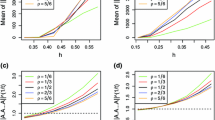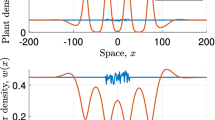Abstract
We propose an integro-difference equation model to predict the spatial spread of a plant population with a seed bank. The formulation of the model consists of a nonmonotone convolution integral operator describing the recruitment and seed dispersal and a linear contraction operator addressing the effect of the seed bank. The recursion operator of the model is noncompact, which poses a challenge to establishing the existence of traveling wave solutions. We show that the model has a spreading speed, and prove that the spreading speed can be characterized as the slowest speed of a class of traveling wave solutions by using an asymptotic fixed point theorem. Our numerical simulations show that the seed bank has the stabilizing effect on the spatial patterns of traveling wave solutions.
Similar content being viewed by others
References
Allen EJ, Allen LJS, Gilliam X (1996) Dispersal and competition models for plants. J Math Biol 34: 455–481
Diekmann O, Kaper H (1978) On the bounded solutions of a nonlinear convolution equation. Nonlinear Anal 2: 721–737
Edelstein-Keshet L (1988) Mathematical models in biology. Random House, New York
Hardin DP, Takac P, Webb GF (1988a) Asymptotic properties of a continuous-space discrete-time population model in a random environment. Bull Math Biol 26: 361–374
Hardin DP, Takac P, Webb GF (1988b) Dispersion population models discrete in time and space. J Math Biol 28: 1–20
Hastings A, Higgins K (1994) Persistence of transients in spatially structured ecological models. Science 263: 1133–1136
Hsu S-B, Zhao X-Q (2008) Spreading speeds and traveling waves for nonmonotone integrodifference equations. SIAM J Math Anal 40: 776–789
Kot M (1992) Discrete-time traveling waves: ecological examples. J Math Biol 30: 413–436
Kot M (2001) Elements of mathematical ecology. Cambridge University Press, Cambridge
Kot M, Lewis MA, van der Driessche P (1996) Dispersal data and the spread of invading species. Ecology 77: 2027–2042
Kot M, Schaffer WM (1986) Discrete-time growth-dispersal models. Math Biosci 80: 109–136
Kuang JJ, Chesson P (2009) Coexistence of annual plants: generalist seed predation weakens the storage effect. Ecology 90: 170–182
Li B, Lewis MA, Weinberger HF (2009) Existence of traveling waves for integral recursions with nonmonotone growth functions. J Math Biol 58: 323–338
Liang X, Zhao X-Q (2010) Spreading speeds and traveling waves for abstract monostable evolution systems. J Funct Anal 259: 857–903
Lui R (1982a) A nonlinear integral operator arising from a model in population genetics. I. Monotone initial data. SIAM J Math Anal 13: 913–937
Lui R (1982b) A nonlinear integral operator arising from a model in population genetics. II. Initial data with compact support. SIAM J Math Anal 13: 938–953
Lui R (1983) Existence and stability of traveling wave solutions of a nonlinear integral operator. J Math Biol 16: 199–220
MacDonald N, Watkinson AR (1981) Models of an annual plant population with a seedbank. J Theor Biol 93: 643–653
Martin RH (1976) Nonlinear operators and differential equations in Banach spaces. Wiley, New York
Mistro DC, Rodrigue LAD, Ferreira WC Jr (2005) The Africanized honey bee dispersal: a mathematical zoom. Bull Math Biol 67: 281–312
Neubert M, Kot M, Lewis MA (1995) Dispersal and pattern formation in a discrete-time predator-prey model. Theor Popul Biol 48: 7–43
Norghauer JM, Newbery DM (2010) Recruitment limitation after mast-seeding in two African rain forest trees. Ecology 91: 2303–2312
Nussbaum RD (1969) The fixed point index and asymptotic fixed point theorem for k-set-contractions. Bull Am Math Soc 75: 490–495
Pacala SW (1986) Neighborhood models of plant population dynamics. 4. Single-species and multispecies models of annuals with dormant seeds. Am Nat 128: 859–878
Rees M (1997) Seed dormancy. In: Crawley MJ (ed) Plant ecology. Blackwell Science, Malden
Ritland K (1983) The joint evolution of seed dormancy and flowering time in annual plant living in variable environment. Theor Popul Biol 24: 213–243
Silvermann BW (1986) Density estimation for statistics and data analysis. Chapman and Hall, New York
Slatkin M (1973) Gene flow and selection in a cline. Genetics 75: 733–756
Southwood TRE (1978) Ecological methods: with particular reference to the study of insect populations. Chapman and Hall, London
Tarter ME, Lock MD (1993) Model-free curve estimation. Chapman and Hall, New York
Templeton AR, Levin DA (1979) Evolutionary consequences of seeds pools. Am Nat 114: 232–249
Thieme HR (1979) Density-dependent regulation of spatially distributed populations and their asymptotic speed of spread. J Math Biol 8: 173–187
Titchmarsh EC (1986) Introduction to the theory of Fourier integrals. Chelsea, New York
Volkov D, Lui R (2007) Spreading speed and traveling wave solutions of a partially sedentary population. IMA J Appl Math 72: 801–816
Weinberger HF (1978) Asymptotic behavior of a model in population genetics. In: Chadam JM (ed) Nonlinear partial differential equations and applications. Lecture notes in mathematics, vol 648. Springer, Berlin, pp 47–96
Weinberger HF (1982) Long-time behavior of a class of biological models. SIAM J Math Anal 13: 353–396
Author information
Authors and Affiliations
Corresponding author
Additional information
This research was partially supported by the National Science Foundation under Grant DMS-0616445.
Rights and permissions
About this article
Cite this article
Li, B. Traveling wave solutions in a plant population model with a seed bank. J. Math. Biol. 65, 855–873 (2012). https://doi.org/10.1007/s00285-011-0481-x
Received:
Revised:
Published:
Issue Date:
DOI: https://doi.org/10.1007/s00285-011-0481-x




